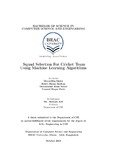| dc.contributor.advisor | Arif, Hossain | |
| dc.contributor.author | Malek, Meraj-Bin- | |
| dc.contributor.author | Badhan, Rakib Hasan | |
| dc.contributor.author | Shesir, Mohaiminul Islam | |
| dc.contributor.author | Fakir, Nazmul Haque | |
| dc.date.accessioned | 2019-07-02T09:47:24Z | |
| dc.date.available | 2019-07-02T09:47:24Z | |
| dc.date.copyright | 2018 | |
| dc.date.issued | 2018-10 | |
| dc.identifier.other | ID 14101238 | |
| dc.identifier.other | ID 14101212 | |
| dc.identifier.other | ID 13201041 | |
| dc.identifier.other | ID 17241019 | |
| dc.identifier.uri | http://hdl.handle.net/10361/12296 | |
| dc.description | This thesis is submitted in partial fulfillment of the requirements for the degree of Bachelor of Science in Computer Science and Engineering, 2018. | en_US |
| dc.description | Cataloged from PDF version of thesis. | |
| dc.description | Includes bibliographical references (pages 53-54). | |
| dc.description.abstract | There are mainly three renowned formats of cricket – ODI (One Day International), Test
Match and T20 (Twenty Twenty). Selecting a 15 men perfect squad for a particular cricket
match in a particular cricket tournament isn’t an easy task. Coach and captain play a vital
role to select the most perfect players for a match to win by keeping many parameters in their
head such as – analyzing the past scored runs comparing with the balls faced, strike rate,
total 50’s , total 100’s, whether the player is right handed or left handed, against which team
she/ he has scored well enough (for batsman). Analyzing the past conceded runs comparing
with the overs she/ he had taken, economy rate, strike rate, wickets, against which team she/
he has performed well, pitch condition, venue etc. In this paper, we have taken maximum
number of parameters in consideration for selecting 1 captain (for captaincy issue), 6 batsmen
(top-order, middle-order and finisher), 2 all-rounders, 1 wicket keeper and 5 bowlers (fast
bowlers, spinners). Our model can be extended for the team selection in other formats of
cricket too. We have used k-means clustering, Linear Regression, Naive Bayes and Page
Rank algorithms for selecting batsmen and all-rounders. Support Vector Machine, Naive
Bayes, Linear Regression, Decision Tree and RankSVM have been used for selecting bowlers.
We have used Bar Graph to show the statistics of different parameters for both captain and
wicket-keeper. Our motive is to recommend 15 men squad for a cricket team to the selectors. | en_US |
| dc.description.statementofresponsibility | Meraj-Bin-Malek | |
| dc.description.statementofresponsibility | Rakib Hasan Badhan | |
| dc.description.statementofresponsibility | Mohaiminul Islam Shesir | |
| dc.description.statementofresponsibility | Nazmul Haque Fakir | |
| dc.format.extent | 54 pages | |
| dc.language.iso | en | en_US |
| dc.publisher | Brac University | en_US |
| dc.rights | Brac University theses are protected by copyright. They may be viewed from this source for any purpose, but reproduction or distribution in any format is prohibited without written permission. | |
| dc.subject | Cricket | en_US |
| dc.subject | Algorithms | en_US |
| dc.subject.lcsh | Computer algorithms. | |
| dc.title | Squad selection for cricket team using machine learning algorithms | en_US |
| dc.type | Thesis | en_US |
| dc.contributor.department | Department of Computer Science and Engineering, Brac University | |
| dc.description.degree | B. Computer Science and Engineering | |

